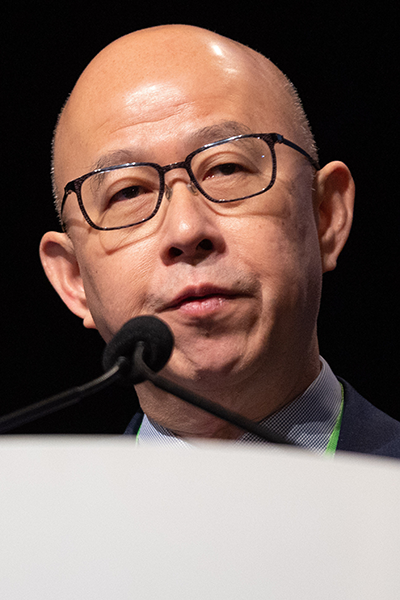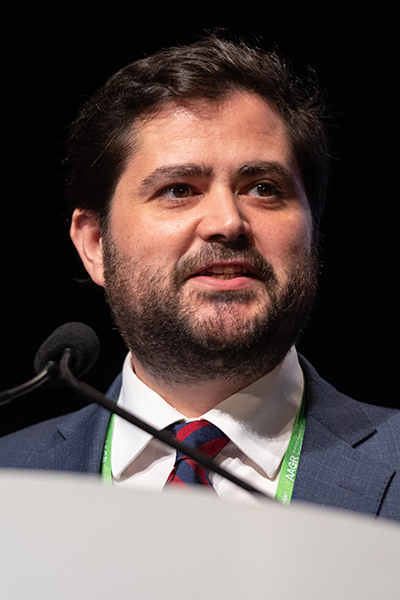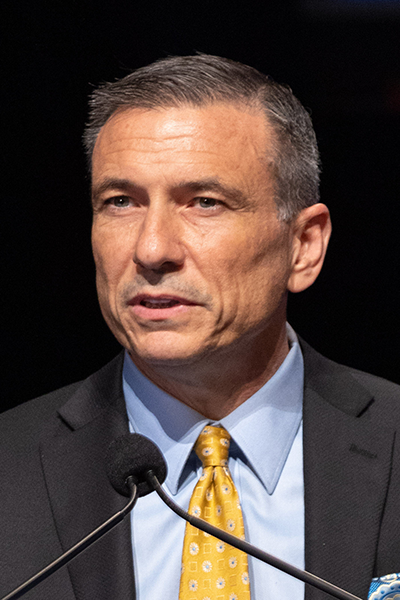Promising study results reported in first clinical trials plenary
//
Estimated Read Time:
The Annual Meeting’s first clinical trials plenary session, Harnessing the Immune System in the Clinic, featured five successful trials using different approaches to tweak the immune system and improve clinical outcomes. Here’s a look at trials showcased during the session, which was originally presented Sunday, April 16, and can be viewed on the virtual meeting platform by registered Annual Meeting participants through July 19, 2023.
First cancer vaccine trial to demonstrate clinical benefit in melanoma

A combination of pembrolizumab plus a novel mRNA-based vaccine based on personalized neoantigens from patients with high-risk resected melanoma showed a 44 percent reduction in the risk of recurrence or death compared to pembrolizumab alone after two years of follow-up in the KEYNOTE-942 trial of mRNA-4157, reported Jeffrey S. Weber, MD, PhD. It’s the first successful cancer vaccine trial in melanoma.
“That neoantigens exist has only become known in the last decade,” said Weber, the Laura and Isaac Perlmutter Professor of Oncology at NYU Grossman School of Medicine. “The neoantigen approach can increase endogenous neoantigen T-cell response and induce epitope spreading.”
Immune checkpoint inhibitors are the standard-of-care adjuvant treatment for high-risk resected melanoma, but half of patients progress within five years, Weber said. High relapse rates illustrate a significant unmet need even with the most effective adjuvant therapies.
Based on the same platform used to develop COVID-19 vaccines, mRNA-4157 is a customizable, individualized therapy encoding up to 34 neoantigens derived from a patient’s own tumor. The trial randomized 107 patients with high-risk resected melanoma to mRNA-4157 plus pembrolizumab, and 50 patients to pembrolizumab alone. The median age of study participants was 60, about 65 percent were male, and most had stage IIIC disease.
The primary endpoint was recurrence-free survival (RFS), and secondary endpoints included distant metastasis-free survival (DMFS), safety, and tolerability.
At 12 months, 83.4 percent in the vaccine arm had RFS versus 77.1 percent of the pembrolizumab-only arm. The 18-month RFS rate was 78.6 percent versus 62.2 percent, respectively. Safety and tolerability were similar in both arms, with infrequent clinically significant adverse events in the vaccine arm versus pembrolizumab alone.
“We will need longer follow-up,” Weber said. “The sponsor will initiate a phase III trial this summer and I am looking forward to getting patients on that trial.”
Perioperative pembrolizumab + neoadjuvant vibostolimab offers promising results

PD-1 inhibitors, including pembrolizumab (pembro), are standard-of-care for stage IV melanoma and as adjuvant treatment in stage III melanoma. Neoadjuvant pembro has improved event-free survival in patients with advanced melanoma versus adjuvant pembro. And phase I studies have shown encouraging antitumor activity for both pembrolizumab plus vibostolimab (vibo), an anti-TIGIT antibody, and pembrolizumab plus gebasaxturev (geba), an oncolytic virus.
The KEYMAKER-U02 Substudy 02C compared neoadjuvant pembro alone against neoadjuvant pembro plus vibo or neoadjuvant pembro plus geba followed by adjuvant pembro for patients with resectable stage IIIB, IIIC, or IIID melanoma. The trial randomized 26 patients to neoadjuvant pembro + vibo (arm 1), 25 patients to neoadjuvant pembro + geba (arm 2), and 15 patients to neoadjuvant pembro alone (arm 3). After resection, all patients received adjuvant pembro for up to one year. Study participants were age 60 on average, mostly male, and about half had stage IIIB disease.
The primary endpoints were safety, tolerability, and pathologic complete response (pCR) by central review. Secondary endpoints included near pCR, pathological partial response (pPR), and RFS. Median follow-up was 14.1 months.
Patients in arm 1 had 81 percent pCR, near pCR, and pPR versus 52 percent in arm 2 and 73 percent in arm 3. Arms 1 and 3 had similar pCR rates but arm 1 had greater near pCR and pPR, reported Reinhard Dummer, MD, PhD, Vice Director of Dermatology and Director of CCCZ Clinical Trials at Comprehensive Cancer Center Zurich, University of Zurich, Switzerland.
None of the arms had reached RFS at data cutoff. At 18 months, arm 1 had 95 percent RFS, arm 2 had 87 percent, and arm 3 had 73 percent. RFS at 18 months was 85 percent, 70 percent, and 78 percent, respectively.
Skin reactions were the most common adverse events in all three arms. Arm 2 had the highest rate of grade 3/4 adverse events, 24 percent, followed by arm 1 with 8 percent and arm 3 with 7 percent.
“Pembro plus vibo looks like an interesting combination,” Dummer said. “There is already a phase III trial underway with more than 1,000 patients.”
Adjuvant atezolizumab + bevacizumab beats active surveillance in high-risk HCC after resection or ablation

The phase III IMbrave050 trial is the first trial of adjuvant treatment for hepatocellular carcinoma (HCC) to show RFS improvement following resection or ablation, reported Pierce Chow, MBBS, PhD, Senior Consultant at National Cancer Center Singapore and Professor and Program Director at Duke-NUS Medical School, Singapore.
Adjuvant atezolizumab (atezo) + bevacizumab (bev) showed a 38 percent improvement in RFS versus active surveillance in patients at high risk for recurrence at a planned interim analysis, he said. Median overall survival has not yet been reached.
“The risk of recurrence after resection or ablation is high, up to 63 percent at five years,” Chow said. “We see a bimodal recurrence after HCC resection – a peak at around one year, likely from micro-metastases, and a second peak of de novo tumors at four to five years associated with underlying liver disease.”
The IMbrave150 study established atezo + bev as the standard-of-care in unresectable HCC, Chow said. The phase III findings informed IMbrave050, which randomized 334 patients with resectable disease to either to adjuvant atezo + bev (334 patients) or to active surveillance (334 patients) over 12 months. Most patients, 83 percent, were male, and 60 years of age on average. Over 80 percent of patients were Asian, 11 percent were white, and 7 percent were of other ethnicities. Most study participants, 62 percent, had hepatitis B and 11 percent had hepatitis C.
Median follow-up at data cutoff was 17.4 months. The active treatment arm had RFS of 78 percent at 12 months versus 65 percent in the active surveillance arm. Disease recurrence was 34 percent in the surveillance group versus 20 percent in the active treatment group at 12 months.
“Results were consistent across all the prespecified subgroups,” Chow reported. “Most patients in the active surveillance arm, 61 percent, crossed over to active treatment as permitted by protocol. Atezo + bev may be a practice-changing option for high-risk HCC patients that could change the clinical indications for surgical resection.”
First-in-human study of intratumoral IL-12 mRNA plus anti-PD-L1 shows positive results in solid tumors

A first-in-human phase I dose escalation trial of intratumoral injections of MEDI1191, an mRNA encoding IL-12, plus durvalumab, showed an objective response rate (ORR) of 8.2 percent and a disease control rate (DCR) of 27.9 percent, reported Eduardo Castañón, MD, PhD, Professor of Medicine and Nursing at the University of Navarra, Madrid, Spain. Duration of response had not been reached at data cutoff.
“All of the patients had some response in the injected lesion,” Castañón said. “What was so interesting was the patients who had a response in the non-injected target lesion.”
The trial randomized 22 patients with cutaneous/subcutaneous or deep-seated solid tumors to escalating doses of MEDI1191 injected directly into a tumor plus intravenous durvalumab for up to two years or until progression or unacceptable toxicity. The trial used a variety of sequential and concurrent dosing schedules.
Primary endpoints were safety, tolerability, and maximum tolerated dose. Secondary endpoints included antitumor activity, pharmacokinetics, and immunogenicity.
Median exposure to MEDI1191 at data cutoff was six weeks, Castañón reported. Nearly all patients reported treatment-emergent adverse events, most commonly fatigue, pyrexia, anemia, diarrhea, nausea, and vomiting. There were no dose-limiting toxicities and the maximum tolerated dose was not reached.
“Several tumor types responded to treatment and the responses are durable,” Castañón said. “Responders included patients with prior anti-PD-L1 and anti-CTLA-4 treatment.”
Perioperative durvalumab-based therapy superior to neoadjuvant chemotherapy alone in NSCLC

Surgery is the primary curative treatment for patients with early-stage, resectable non-small cell lung cancer (NSCLC), but recent trials have shown clinical benefits of immunotherapy in either the neoadjuvant or adjuvant setting.
AEGEAN is the first phase III trial to demonstrate the benefit of perioperative immunotherapy plus neoadjuvant chemotherapy, reported John V. Heymach, MD, PhD, the David Bruton Endowed Chair in Cancer Research and Chair of Thoracic/Head and Neck Medical Oncology at The University of Texas MD Anderson Cancer Center.
“Perioperative regimens could improve long-term clinical outcomes by combining the benefits of neoadjuvant immunotherapy to prime antitumor immunity while the primary tumor and lymph nodes are present, and eradicate micro metastases, with adjuvant therapy,” Heymach said.
AEGEAN randomized 802 patients at 222 sites across 28 countries to neoadjuvant durvalumab + platinum-based chemotherapy plus adjuvant durvalumab (D arm) versus neoadjuvant platinum-based chemotherapy + adjuvant placebo (PBO arm). All patients had resectable NSCLC and were planned to undergo lobectomy, sleeve resection, or bilobectomy. Heymach presented a planned interim analysis.
Study participants were 65 years old on average, about two-thirds were male, and 72.7 percent were expected to go on carboplatin neoadjuvant therapy. Median follow-up was 11.7 months at the planned interim analysis.
At 12 months, the D arm showed 73.4 percent EFS versus 64.5 percent for the PBO arm. The D arm had a 13 percent improvement in pCR (17.21 percent versus 4.28 percent), and adverse event rates were similar between the two groups.
“Benefits were seen broadly across all major subgroups,” Heymach reported. “Perioperative durvalumab plus neoadjuvant chemotherapy is a potential new treatment for patients with resectable NSCLC.”




